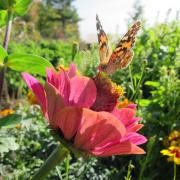MDIFW Blog
Easter’s On Its Way, And Peter Cottontail Needs Your Help!
[caption id="attachment_2798" align="alignright" width="518"] New England cottontails such as this one rely on thickets of dense shrubs and young trees.[/caption] By MDIFW Wildlife Biologist Cory Stearns With Easter nearly here, you might find yourself breaking into renditions of “Here comes Peter Cottontail, hopping down the bunny trail, hippity, hoppity, Easter’s on it’
Maine Warden Service Receives Special Donation From Maine Guide Snowshoe
By Corporal John MacDonald, Maine Warden Service The Maine Warden Service was recently provided with a special gift, one that is at the heart of any outdoor enthusiast who loves a good Maine winter. Nine pair of genuine, Maine-made snowshoes were donated to the newest graduating class of game wardens to use in their missions that range from fish and wildlife conservation, search and rescue and public safety. These aren’t just any pair of snowshoes, these are the best in the business.
Why Do We Manage Grasslands With Delayed Mowing?
[caption id="attachment_2785" align="alignright" width="463"] Male (Left) and Female (Right) Bobolink (Dolichonyx oryzivorus). Photo courtesy of National Audobon Society[/caption] By Natural Resource Manager Daniel H. Hill Did you know that managed grasslands and hay fields are important, intricate ecosystems found throughout the State of Maine? Did you know they were in decline?

Creating Backyard Habitat for Bees And Butterflies
Many of us have heard about widespread declines of some pollinator species. Not only do bees and butterflies play a critical role in natural ecosystems and in agriculture by pollinating plants, but they’re pretty cool to look at too!
Fishing and Social Media: Your Secret Spot Isn’t a Secret Anymore
By MDIFW Fisheries Biologist Jason Seiders We’ve all seen it, and some of us are guilty of it. Someone catches a big fish and they can’t wait to share it with their friends. A nice photo of a happy, smiling angler holding a big fish.
American Sport Fish Society Recognizes Maine for Arctic Charr Restoration
Last week, our Fisheries Division received national attention for their work restoring native Arctic charr to Big Reed Pond in northern Piscataquis county.
Learning More About Lynx During The Winter Months
By Regional Wildlife Biologist Scott McLellan One of the responsibilities of a wildlife biologist in the Moosehead Lake region is to research and collect information about Canada lynx. Most townships within this region have lynx present, which was not the case 20 years ago.
Cold Winters and Hot Togue Fishing on Sebago Lake
By Assistant Regional Fisheries Biologist Nick Kalejs Thanks to a frigid start to the ice fishing season, many of Maine’s lakes have had the chance to accumulate a solid base of ice. While ice can never be considered completely safe without careful consideration, especially given changing ice conditions due to recent warm weather, many anglers have found that this season has provided plenty of opportunity to find thick ice and get in some quality fishing time.
Sarah's Journey to Becoming a Regional Wildlife Biologist at MDIFW
By Regional Wildlife Biologist, Sarah Boyden Quite often, I get asked how I became a wildlife biologist. As a kid, on a dairy farm in central Maine, I didn’t know what I wanted to be when I grew up. I liked to be outside and I wanted to do something with animals but, beyond that, I had no plans.
Winter Is Baitfish Dealer Inspection Time
[caption id="attachment_2702" align="alignright" width="396"] Bio Specialist Kevin Gallant conducts a Baitfish Dealer Inspection.[/caption] By Merry Gallagher, Native Fish Conservation Biologist Did you know that IFW manages some fisheries for commercial harvest? Most anglers are certainly aware that the live fish that they may use as bait are often wild caught from Maine waters by either
Keep In Touch!
Enter your email or mobile number to receive the latest news from MDIFW.